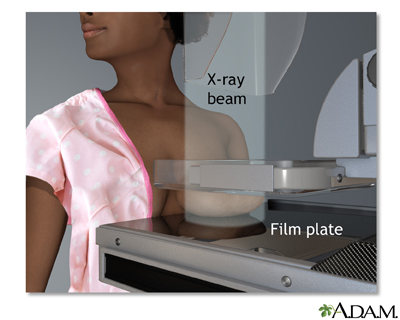Health Library
Mammogram - calcifications
Microcalcifications or macrocalcifications; Breast cancer - calcifications; Mammography - calcifications
Calcifications are tiny deposits of calcium in your breast tissue. They are often seen on a mammogram.
Images

I Would Like to Learn About:
Information
The calcium you eat or take in as medicine does not cause calcifications in the breast.
Most calcifications are not a sign of cancer. Causes may include:
- Calcium deposits in the arteries inside your breasts
- History of breast infection
- Noncancerous (benign) breast lumps or cysts
- Past injury to the breast tissue
- Fat necrosis (breast tissue damage, usually from injury or trauma)
Large, rounded calcifications (macrocalcifications) are common in women over age 50. They look like small white dots on the mammogram. They are most likely not related to cancer. You will rarely need more testing.
Microcalcifications are tiny calcium specks seen on a mammogram. Most of the time, they are not cancer. However, these areas may need to be checked more closely if they have a certain appearance on the mammogram.
WHEN IS FURTHER TESTING NEEDED?
When microcalcifications are present on a mammogram, the doctor (a radiologist) may ask for a larger view so the areas can be examined more closely.
Calcifications that do not appear to be a problem are called benign. No specific follow-up is needed. But, your health care provider may recommend that you get a mammogram each year.
In some cases, calcifications that are slightly abnormal but do not look like a problem (such as cancer) are also called benign. Most women will need to have a follow-up mammogram in 6 months.
Calcifications that are irregular in size or shape or are tightly clustered together, are called suspicious calcifications. Your provider will recommend a stereotactic core biopsy. This is a needle biopsy that uses a type of mammogram machine to help find the calcifications. The purpose of the biopsy is to find out if the calcifications are benign (not cancer) or malignant (cancer).
Most women who have suspicious calcifications do not have cancer.
References
Ikeda DM, Miyake KK. Mammographic analysis of breast calcifications. In: Ikeda DM, Miyake KK, eds. Breast Imaging: The Requisites. 3rd ed. St Louis, MO: Elsevier; 2017:chap 3.
James JJ, Evans AJ. The breast. In: Adam A, Dixon AK, Gillard JH, Schaefer-Prokop CM, eds. Grainger & Allison's Diagnostic Radiology. 7th ed. Philadelphia, PA: Elsevier; 2021:chap 63.
Siu AL; US Preventive Services Task Force. Screening for breast cancer: US Preventive Services Task Force recommendation statement. Ann Intern Med. 2016;164(4):279-296. PMID: 26757170 pubmed.ncbi.nlm.nih.gov/26757170/.
BACK TO TOPReview Date: 1/1/2022
Reviewed By: Neil Grossman, MD, MetroWest Radiology Associates, Framingham, MA. Review provided by VeriMed Healthcare Network. Also reviewed by David Zieve, MD, MHA, Medical Director, Brenda Conaway, Editorial Director, and the A.D.A.M. Editorial team.
 | A.D.A.M., Inc. is accredited by URAC, for Health Content Provider (www.urac.org). URAC's accreditation program is an independent audit to verify that A.D.A.M. follows rigorous standards of quality and accountability. A.D.A.M. is among the first to achieve this important distinction for online health information and services. Learn more about A.D.A.M.'s editorial policy, editorial process and privacy policy. A.D.A.M. is also a founding member of Hi-Ethics. This site complies with the HONcode standard for trustworthy health information: verify here. |
The information provided herein should not be used during any medical emergency or for the diagnosis or treatment of any medical condition. A licensed medical professional should be consulted for diagnosis and treatment of any and all medical conditions. Links to other sites are provided for information only -- they do not constitute endorsements of those other sites. © 1997- 2022 A.D.A.M., a business unit of Ebix, Inc. Any duplication or distribution of the information contained herein is strictly prohibited.
